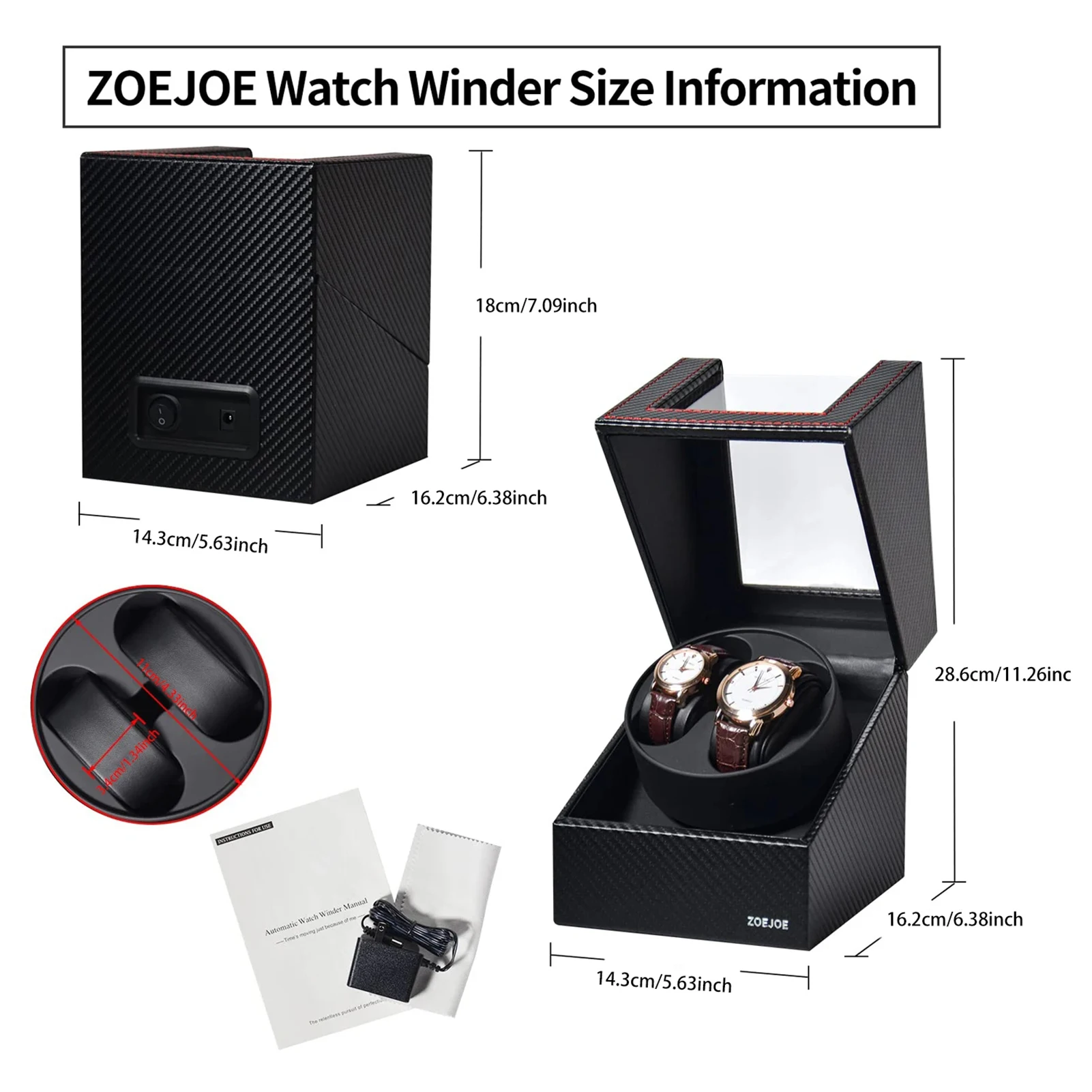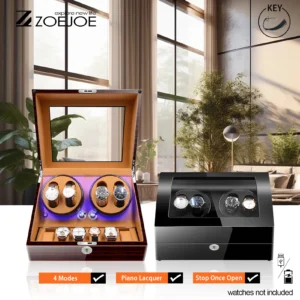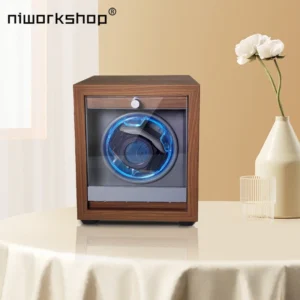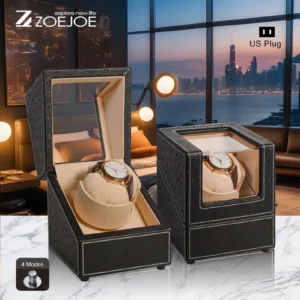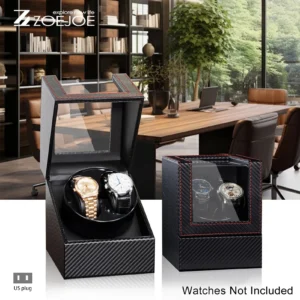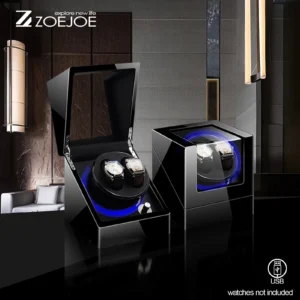Understanding Watch Winders and Their Critical Role in Automatic Watch Care
Automatic watches represent a fascinating blend of artistry and engineering. Unlike quartz watches that run on batteries, automatic timepieces are powered by the natural motion of your wrist, which winds a mainspring through a weighted rotor. This ingenious mechanism, which evolved from pocket watches, creates a self-sustaining system that requires no batteries—but it does require regular movement.
This is where watch winders enter the picture. These specialized devices simulate the natural motion of your wrist when you’re not wearing your watch, ensuring your automatic timepiece remains wound and ready to wear.
Why are precise settings so crucial for these devices? Consider these key factors:
- Proper maintenance: Incorrect settings can lead to unnecessary wear on your watch movement
- Accuracy preservation: The right settings maintain your watch’s timekeeping precision
- Lubrication distribution: Proper winding ensures oils inside the movement remain evenly distributed
- Cost efficiency: Professional watch servicing typically costs $200-800+, which proper care can help delay
The two critical settings for any watch winder are Turns Per Day (TPD) and winding direction. Getting these right isn’t just about convenience—it’s about preserving the integrity and lifespan of your timepiece.
In this guide, we’ll walk through everything you need to know about finding the right watch winder programming settings for any watch movement type, helping you protect your investment for years to come. Whether you’re exploring different types of watch winders or setting up your first one, understanding these principles is essential.
The Science Behind Turns Per Day (TPD) and Winding Direction
Turns Per Day (TPD) represents the number of complete rotations a watch winder makes in a 24-hour period. This seemingly simple number is actually crucial to maintaining your watch’s power reserve—the amount of energy stored in the mainspring that keeps your watch running when not worn.
Different watches require different TPD settings due to variations in:
- Mainspring design and capacity
- Power reserve duration (typically ranging from 38-80 hours)
- Winding efficiency of the movement
- Rotor design and weight
Most automatic watches require between 650-1800 TPD. Lower TPD watches (650-800) typically include many Rolex models and ETA-based movements, while higher TPD requirements (1200+) are common in many Omega and Seiko calibers.
Equally important is winding direction, which comes in three varieties:
- Clockwise (CW): The winder rotates only in a clockwise direction
- Counter-Clockwise (CCW): The winder rotates only counterclockwise
- Bi-directional (BD): The winder alternates between clockwise and counterclockwise rotations
The required direction is determined by your watch’s rotor design. Some rotors wind the mainspring in only one direction, while others are designed to wind in both directions as they rotate.
Many watch owners worry about “overwinding” their timepieces with a winder. Fortunately, most modern automatic watches contain a slip-clutch mechanism that prevents damage once the mainspring reaches full capacity. However, using dramatically excessive TPD settings still puts unnecessary wear on these protective mechanisms.
Understanding the detailed explanation of TPD requirements helps you make informed choices about your watch care. Once you grasp these concepts, selecting the right automatic watch winder with programmable settings becomes much easier.
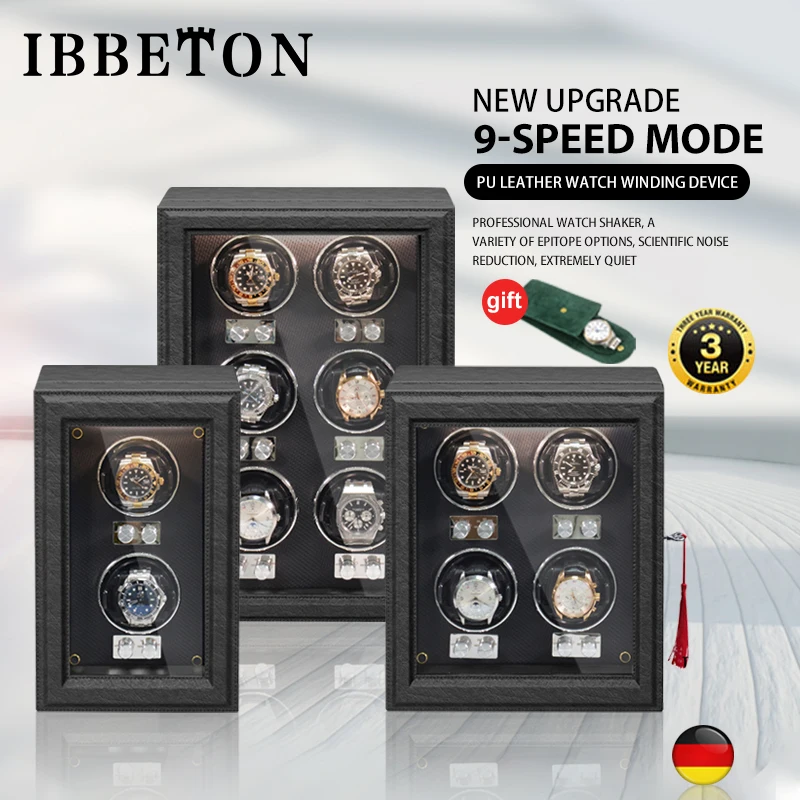
How to Identify Your Watch’s Movement Type
Before you can determine the correct winder settings, you’ll need to identify exactly what movement powers your timepiece. Here are reliable methods to discover this crucial information:
Check the Documentation
– Review your watch manual or warranty card, which often specifies the caliber
– Examine any paperwork that came with your purchase
– Look for caliber numbers or movement specifications
Examine the Watch Itself
– Look for inscriptions on the case back (may require a magnifying glass)
– If your watch has a display case back, visually identify the movement
– Note any reference numbers, which can be researched online
Use the Model Number
– Most watch brands use reference numbers that indicate the movement type
– For example, many Rolex reference numbers correlate to specific calibers
– Research your model number on manufacturer websites or watch forums
Identify Major Movement Manufacturers
– ETA: The largest Swiss movement supplier (look for numbers like 2824-2, 2892-A2)
– Miyota: Japanese movements commonly found in many watch brands
– Sellita: Swiss alternatives to ETA (look for SW200, SW300 designations)
– In-house calibers: Unique to specific brands like Rolex, Omega, or Grand Seiko
For vintage watches with limited documentation, you might need to consult a watchmaker for positive identification. Many vintage timepieces have specific winding requirements that differ from modern counterparts.
Once you’ve identified your movement, you can refer to our comprehensive database in the following sections to find the proper settings. The ultimate guide on direction settings offers additional details for those with complex needs. For collectors with multiple high-end timepieces, luxury watch winders with advanced setting capabilities provide the flexibility to accommodate various movement types.
Popular Watch Brands and Their Recommended Winder Settings
Finding the right settings for your specific watch becomes much simpler with this comprehensive reference table. Below, we’ve compiled the recommended settings for popular watch brands and their common movements:
| Brand | Common Calibers | TPD Range | Direction | Notes |
|---|---|---|---|---|
| Rolex | 3135, 3235, 3255 | 650-750 | Bi-directional | Modern Rolex movements have 70-hour power reserves |
| Omega | 8500, 8900, 9300 | 800-900 | Bi-directional | Co-Axial escapements benefit from consistent winding |
| TAG Heuer | Calibre 5, Heuer 02 | 800-1000 | Bi-directional | Chronographs may benefit from higher TPD |
| Breitling | B01, B20 | 750-850 | Bi-directional | Standard setting works for most models |
| IWC | 52000, 82000 | 800-1000 | Bi-directional | Pellaton winding system is highly efficient |
| Patek Philippe | 324, 240, 215 | 800-1000 | Bi-directional | Handle with extreme care due to value |
| Audemars Piguet | 3120, 4302 | 800-950 | Bi-directional | Royal Oak models typically use these calibers |
| Tudor | MT5601, MT5612 | 650-750 | Bi-directional | Similar to Rolex but with different finishing |
| Seiko | 6R15, 4R36, 8L35 | 800-850 | Bi-directional | Japanese movements often require higher TPD |
| Grand Seiko | 9S65, 9S85 | 800-850 | Bi-directional | Spring Drive models have different requirements |
| Longines | L888, L619 (ETA 2892) | 650-800 | Bi-directional | ETA-based movements with modifications |
| Oris | Oris 400, 733 (SW200-1) | 650-800 | Bi-directional | Mix of proprietary and Sellita-based calibers |
| Hamilton | H-10, H-30 (ETA based) | 650-800 | Bi-directional | Extended 80-hour power reserve |
| Tissot | Powermatic 80 | 650-800 | Bi-directional | Modified ETA with 80-hour reserve |
| Panerai | P.9000, P.4000 | 800-900 | Bi-directional | Heavy watches with robust movements |
| Cartier | 1847 MC, Calibre de Cartier | 800-900 | Bi-directional | In-house movements have specific requirements |
| Jaeger-LeCoultre | Calibre 899, 925 | 800-1000 | Bi-directional | Higher precision movements with fine adjustment |
| Zenith | El Primero | 800-1000 | Bi-directional | High-frequency movements (36,000 vph) |
For certain high-complexity watches like perpetual calendars or watches with extended power reserves (over 3 days), you may need to adjust these settings. When in doubt, it’s generally safer to slightly under-wind than over-wind.
Additional settings for specific watch movement types can help with less common timepieces not listed in this table.
Movement Manufacturers and Their Caliber Settings
For those who know their specific movement rather than just the watch brand, this section organizes winder settings by caliber manufacturer. This approach is particularly useful for watches that use common third-party movements:
ETA Movements (Swiss)
| Caliber | TPD Range | Direction | Notable Features |
|---|---|---|---|
| ETA 2824-2 | 650-800 | Bi-directional | Workhorse movement used by many brands |
| ETA 2892-A2 | 650-800 | Bi-directional | Premium movement, thinner profile |
| ETA 7750 | 800-1000 | Bi-directional | Chronograph movement |
| ETA 2671 | 650-800 | Bi-directional | Smaller caliber for ladies’ watches |
| ETA 2834-2 | 650-800 | Bi-directional | Day-date variant of 2824 |
Sellita Movements (Swiss)
| Caliber | TPD Range | Direction | Notable Features |
|---|---|---|---|
| SW200-1 | 650-800 | Bi-directional | ETA 2824-2 equivalent |
| SW300-1 | 650-800 | Bi-directional | ETA 2892-A2 equivalent |
| SW500 | 800-1000 | Bi-directional | Chronograph, similar to ETA 7750 |
| SW240-1 | 650-800 | Bi-directional | Day-date function |
Miyota Movements (Japanese)
| Caliber | TPD Range | Direction | Notable Features |
|---|---|---|---|
| 9015 | 800-850 | Bi-directional | High-beat, smooth sweep seconds |
| 9039 | 800-850 | Bi-directional | No-date version of 9015 |
| 8215 | 800-850 | Bi-directional | Budget movement, non-hacking |
| 821A | 800-850 | Bi-directional | Updated 8215 with hacking |
| 9075 | 800-850 | Bi-directional | GMT function |
Seiko Movements (Japanese)
| Caliber | TPD Range | Direction | Notable Features |
|---|---|---|---|
| NH35/NH35A | 800-850 | Bi-directional | Workhorse automatic (4R35 export) |
| 4R36 | 800-850 | Bi-directional | Day-date variant |
| 6R15 | 800-850 | Bi-directional | Higher-end with better accuracy |
| 6R35 | 800-850 | Bi-directional | Extended 70hr power reserve |
| 8L35 | 800-850 | Bi-directional | Grand Seiko derived movement |
| 7S26 | 800-850 | Bi-directional | Older non-hacking movement |
Other Notable Manufacturers
| Manufacturer/Caliber | TPD Range | Direction | Notable Features |
|---|---|---|---|
| Soprod P5000 (A-10) | 800-950 | Bi-directional | ETA alternative, high grade |
| La Joux-Perret G100 | 750-850 | Bi-directional | Premium movement supplier |
| Kenissi MT56xx series | 650-750 | Bi-directional | Used by Tudor and other brands |
| STP 1-11 | 650-800 | Bi-directional | Swiss ETA alternative |
These specifications provide starting points for optimal winding. The actual power reserve of your watch may vary depending on its age, service history, and individual characteristics.

Troubleshooting Common Watch Winding Issues
Even with the correct settings, you might encounter issues with your watch winder. Here are solutions to common problems:
Problem: My watch stops despite being on a winder
– Verify your TPD setting is high enough for your movement
– Check that the watch is properly seated in the winder
– Ensure the watch is fully wound before placing it in the winder
– Try increasing TPD by 100-200 turns
– Verify your watch doesn’t need servicing (poor power reserve often indicates maintenance needs)
Problem: My watch runs fast or slow on the winder
– Ensure the winder isn’t placed near magnetic fields
– Check that the watch isn’t experiencing position errors (try different orientations)
– Reduce TPD if the watch is consistently running fast
– Consider having the watch regulated by a professional
Problem: I can’t find settings for my specific movement
– Start with 800 TPD and bi-directional rotation as a safe middle ground
– Monitor the watch’s performance for 48 hours
– Adjust gradually (increase by 100 TPD if power reserve isn’t maintained)
– Consult with the watch manufacturer directly
– Visit watch enthusiast forums for crowdsourced information
Problem: My winder makes noise or moves erratically
– Check that the watch is balanced in the holder
– Verify the winder is on a level surface
– Ensure the power adapter is properly connected
– Consider if the winder itself needs maintenance or replacement
If basic troubleshooting doesn’t resolve your issues, our guide on solutions for watch winder issues offers more in-depth assistance. For precise testing of individual watches, single watch winders allow you to find optimal settings for each timepiece.
Best Practices for Using Watch Winders Effectively
Follow these recommendations to maximize the benefits of your watch winder while minimizing potential issues:
Fully wind your watch manually before placement: This ensures the mainspring starts from optimal tension.
Position the watch correctly: Center the timepiece in the holder with proper balance to prevent unnecessary strain on the movement.
Control the environment: Keep your winder in a location with stable temperature (65-75°F or 18-24°C) and moderate humidity (40-60%). Avoid direct sunlight and strong magnetic fields.
Consider rotation schedules: Many premium winders offer intermittent rotation options rather than continuous movement, which better mimics actual wear patterns.
Maintain your winder: Keep the mechanisms clean, check power connections regularly, and follow the manufacturer’s maintenance recommendations.
Be selective about which watches you keep wound: Consider rotating which watches are in the winder if you have a large collection, as some watchmakers suggest periodic rest periods.
Exercise caution with vintage pieces: Watches made before the 1960s may lack modern protection mechanisms and could be damaged by continuous winding.
Monitor performance: Periodically check that your watches maintain accurate time and expected power reserve when removed from the winder.
These practices help ensure your watch collection remains in excellent condition while in storage. For collectors with multiple timepieces, multi-watch winders for collectors offer efficient solutions for maintaining several watches simultaneously.
Automatic Watch Winder, Luxury Watch Winder, Single Watch Box
$307.39 Select options This product has multiple variants. The options may be chosen on the product page4 Watch Winder, 6 Watch Box, Automatic Watch Winder
$512.31 Select options This product has multiple variants. The options may be chosen on the product pageAutomatic Watch Winder, Single Watch Winder, Wooden Watch Holder
$201.76 Select options This product has multiple variants. The options may be chosen on the product pageAutomatic Watch Winder, Leather Watch Travel Case, Single Watch Winder
$146.30 Select options This product has multiple variants. The options may be chosen on the product pageAutomatic Watch Winder, Double Watch Winder, Leather Watch Boxes
$147.60 Select options This product has multiple variants. The options may be chosen on the product pageAutomatic Watch Winder, Double Watch Winder
$206.18 Select options This product has multiple variants. The options may be chosen on the product page
How to Select the Right Watch Winder for Your Collection
Choosing the appropriate watch winder involves considering several key factors that affect both your watches’ care and your overall experience:
Essential Features to Consider:
– Programmable Settings: Look for winders with adjustable TPD settings (ideally between 650-1900) and directional control (CW, CCW, and bi-directional options).
– Quality Motors: Premium winders use Japanese motors that operate quietly and provide consistent rotation over many years.
– Capacity Planning: Consider your current collection size and potential growth when deciding between single winders, double winders, or multi-watch options.
– Power Options: AC adapters provide reliability for home use, while battery options offer flexibility for travel or homes with limited outlets.
– Construction Quality: Solid wood cabinets, quality bearings, and proper cushioning protect your watches better than plastic alternatives.
Investment Considerations:
– Entry-level winders ($100-200) may lack precise settings control and durability
– Mid-range options ($300-500) typically offer good value with reliable motors and adjustable settings
– Premium winders ($500+) provide superior construction, quieter operation, and advanced programming options
Advanced Features Worth Considering:
– Touch screen controls for intuitive programming
– Humidity and temperature controls for optimal storage
– Fingerprint or key locks for valuable collections
– Smart connectivity for remote monitoring and control
Remember that a quality watch winder is an investment in preserving the value and functionality of your timepieces. The programming guide for watch winders can help you make full use of your winder’s features once you’ve made your selection.
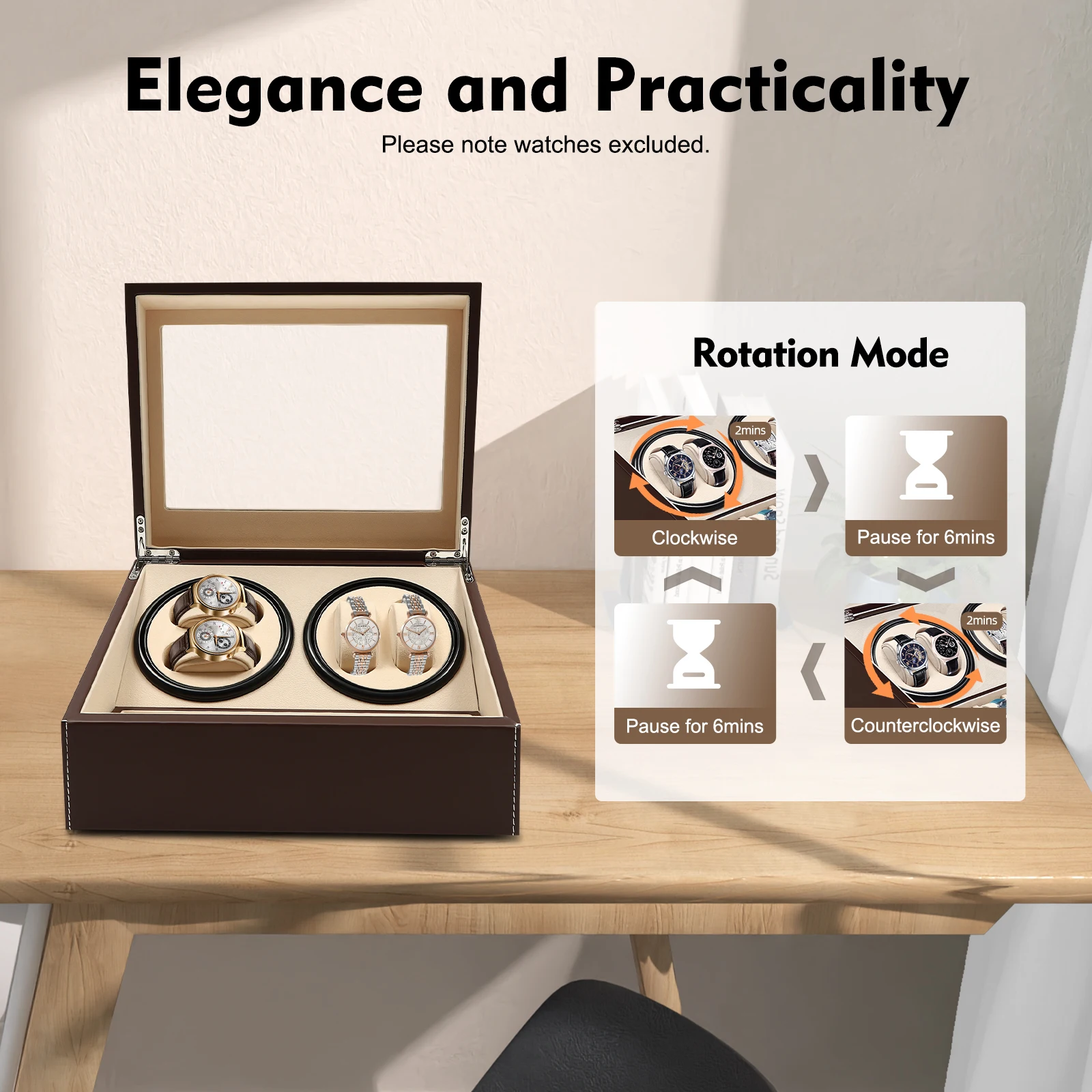
Special Considerations for High-Complication Timepieces
Watches with advanced complications require special attention when using a watch winder. Their complex mechanisms often have unique winding requirements:
Perpetual Calendars
These sophisticated timepieces track dates, months, leap years, and sometimes moon phases without adjustment for decades. When using a winder:
– Maintain consistent winding to prevent calendar mechanisms from losing synchronization
– Use the lower end of the recommended TPD range to reduce wear
– Consider periodic manual winding to verify proper function
Moon Phase Complications
Watches displaying the lunar cycle require special handling:
– The moon phase disc advances slowly through internal gearing
– Consistent power is crucial to maintaining accurate lunar tracking
– Use the manufacturer’s recommended settings precisely
Chronographs
These watches with stopwatch functionality have additional considerations:
– Never place a chronograph in a winder with the stopwatch function engaged
– Some chronograph movements require slightly higher TPD settings
– Column-wheel chronographs generally benefit from more gentle (lower) TPD settings
GMT and World Time Watches
These travel-oriented watches track multiple time zones:
– Their additional hands and mechanisms create more internal resistance
– Follow brand-specific guidelines, as requirements vary widely between manufacturers
– When in doubt, consult the manufacturer directly
Extended Power Reserve Watches
Modern watches with 3+ day power reserves (like many Rolex, Omega, and Panerai models):
– Often need less frequent winding
– Can typically use lower TPD settings
– May benefit from intermittent rather than continuous rotation cycles
For collectors with these special timepieces, investing in higher-quality winders with precise, adjustable settings is particularly important to preserve both function and value.
Frequently Asked Questions About Watch Winder Settings
Can I damage my watch with incorrect winder settings?
While modern watches have safeguards against overwinding, consistently incorrect settings can cause unnecessary wear. Using significantly excessive TPD can stress components, while insufficient TPD fails to maintain proper lubrication distribution. Stay within manufacturer recommendations whenever possible.
How often should I use my watch winder?
For watches worn in rotation, use the winder when the watch isn’t being worn. For rarely worn pieces, some collectors prefer periodic manual winding instead of continuous winder use. There’s no universal answer—both approaches have merits depending on your wearing patterns.
Do all automatic watches need a winder?
No. Watches worn daily generally don’t need winders. Winders are most beneficial for collections where watches might sit unworn for weeks, or for complicated watches that are difficult to reset after stopping.
What if my specific movement isn’t listed anywhere?
Start with conservative settings (800 TPD, bi-directional) and monitor performance. Adjust gradually if needed. When truly uncertain, consult the manufacturer directly or ask a professional watchmaker familiar with your specific movement.
Is it better to slightly under-wind or over-wind?
When uncertain, slightly under-winding is generally preferable. Modern watches have slip mechanisms to prevent damage from overwinding, but these mechanisms themselves can wear with excessive use.
Can I leave my watch on a winder indefinitely?
Technically yes, but many experts suggest periodic rest periods to reduce continuous wear on pivot points. Consider rotating watches through your winder if you have multiple timepieces.
How do I know if my winder is functioning correctly?
Monitor your watch’s timekeeping after removing it from the winder. A properly wound watch should maintain its expected power reserve. You can also mark the position of the rotor (visible through a display caseback) and check if it moves after a few hours on the winder.
For more detailed information on getting the most from your winder, explore our expert recommendations on optimal settings resource.
By following the guidelines in this comprehensive guide, you’ll ensure your cherished timepieces receive the proper care they deserve, extending their lifespan and maintaining their accuracy for years to come.

